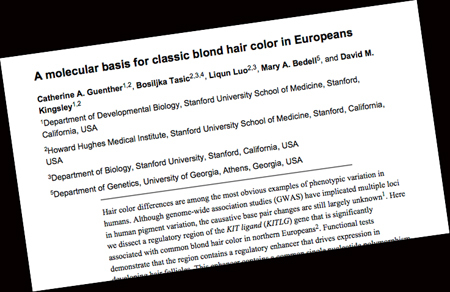Marc Abrahams's Blog, page 275
April 11, 2016
Ig Nobel winner Goldman Sachs admits innovations
 Goldman Sachs, a corporation that shared the 2010 Ig Nobel economics prize, has shed some of its modesty about the innovations that earned that prize. Fortune magazine reports today:
Goldman Sachs, a corporation that shared the 2010 Ig Nobel economics prize, has shed some of its modesty about the innovations that earned that prize. Fortune magazine reports today:
Goldman Sachs Finally Admits it Defrauded Investors During the Financial Crisis
Goldman Sachs effectively admitted that it had knowingly misled investors to buy shoddy products.
Investment banking giant Goldman Sachs GS 1.28% has agreed to a list of “facts” in addition to paying $5.1 billion to settle a lawsuit related to its handling of mortgage-backed securities leading up to the 2007 financial crisis, the U.S. Department of Justice announced Monday….
The 2010 Ig Nobel economics Prize was awarded to the executives and directors of Goldman Sachs, AIG, Lehman Brothers, Bear Stearns, Merrill Lynch, and Magnetar for creating and promoting new ways to invest money — ways that maximize financial gain and minimize financial risk for the world economy, or for a portion thereof.
BONUS: “The Big Bank Opera”, a mini-opera that premiered at the 2009 Ig Nobel Prize ceremony, honored some of those innovations. Here is video of Act 3 of that opera:

The trouble with emoji: Misinterpreted emotions
The world suffers from miscommunication due to ambiguous interpretation of emoji, explains a soon-to-be-published study:
The study is called ” ‘Blissfully happy’ or ‘ready to fight’: Varying Interpretations of Emoji.”
Authors Hannah Miller, Jacob Thebault-Spieker, Shuo Chang, Isaac Johnson, Loren Terveen, and Brent Hecht, are in the GroupLens Research group at the University of Minnesota. In the study, they write:
“We explore whether emoji renderings or differences across platforms give rise to diverse interpretations of emoji… In cases in which participants rated the same emoji rendering, they disagreed on whether the sentiment was positive, neutral, or negative 25% of the time. When considering renderings across platforms, these disagreements only increase. Overall, we find significant potential for miscommunication, both for individual emoji renderings and for different emoji renderings across platforms.”
The authors have a short online essay about this, too.

Introducing the SPOT effect : “Spontaneous Preference for their Own Theories”
A research team from the Centre for Research on Self and Identity (CRSI) at the University of Southampton, UK, have identified a new psychological bias, which they are calling : “Spontaneous Preference for their Own Theories” – SPOT. A series of three experiments showed that :
“[…] even where theory ownership is established in the most minimal of ways— simply by asking participants to imagine that a theory is theirs rather than someone else’s or nobody’s in particular—participants are inclined to increase their estimates of the likelihood that that theory is true, as they consider successive items of evidence bearing on the truth of that theory.”
“To test the SPOT effect, we described a fantasy scenario in which, on a faraway planet, two species of alien existed. The theory at issue was that one of the species was a predator, whereas the other one was its prey. The theory was initially stated, accompanied by a piece of evidence bearing on it. Participants were then asked to rate the likelihood of the theory being true or false. Thereafter, additional pieces of evidence were each presented in turn, and, after each one, participants completed the same rating task. An arbitrary link to self was (or was not) created by altering the wording of the theory’s presentation, such that it was introduced and then repeatedly described as being (or as not being) the participant’s own theory.”
The paper does however, ask (and answer) :
“How significant is the SPOT effect? The effect sizes we obtained across three experiments ranged from d = .23 to d = .34, which places them, by convention, into the ‘small’ category (Cohen, 1988).”
See: The SPOT Effect: People Spontaneously Prefer their Own Theories in: The Quarterly Journal of Experimental Psychology, Feb. 2016.
BONUS The paper’s lead author professor Aiden Gregg on ‘The Psychology of Anarchy’

April 10, 2016
Finding half a maggot is worse: Limits have their limits
“Biting into an apple and finding a maggot is unpleasant enough, but finding half a maggot is worse. Discovering one-third of a maggot would be more distressing still: The less you find, the more you might have eaten. Extrapolating to the limit, an encounter with no maggot at all should be the ultimate bad-apple experience. This remorseless logic fails, however, because the limit is singular: A very small maggot fraction is qualitatively different from no maggot….”
So writes Michael Berry in his essay called “Singular Limits“, in the May 2002 issue of Physics Today.
BONUS: The 2000 Ig Nobel Prize for physics was awarded to Andre Geim and Michael Berry for using magnets to levitate a frog. [REFERENCE: “Of Flying Frogs and Levitrons” by M.V. Berry and A.K. Geim, European Journal of Physics, v. 18, 1997, p. 307-13.]
BONUS: Mason Porter’s thoughts on maggot biting.

Up in the air, junior birdman, and then down.
“An executive of a company that develops jetpacks is in serious condition after crashing during a test flight of one of his products in Denver,” reports the Associated Press. Photos, post-crash, are on display in the SFGate version of that AP report. (Thanks to Adam K. Olson for bringing this to our attention.)
A CBS News report last July says: “According to Nick ‘The Jet Pack Man’ Macomber, it won’t be long before people will be able to fly short distances in their own machines.” That proved to be correct.
A generation or more of bold experimenters took flight, or thought about trying, inspired by the song “Up in the air, junior birdmen!” Here are some video tributes to that song and those people.

Fujitsu promotes the Internet of Cows
Fujitsu devised this promotional video for what it calls “the Internet of Cows”:
.
Fujitsu’s more formal name for the innovation is “ox walk SaaS“. Fujitsu’s promotional activities turn on the phrase “I am the connected cow”, as you can see in this photo:
Michael Byrne wrote a short essay about this cow news, for Motherboard.

April 9, 2016
Cops Consumption of Psychic CSI Concepts from TV
Cops, psychics, and TV cop shows with psychics all figure, if that is the word, into this study:
“Sci., Psi, and CSI: Police Officers and Students’ Paranormal TV Consumption, Real-Life Experience with Paranormal Phenomena, and Perceptions of Psychic Detectives,” Susan H. Sarapin and Glenn G. Sparks, Journal of Police and Criminal Psychology, Volume 30, Issue 3, September 2015, pp. 191-203. The authors, at Troy University and Purdue University, explain:
“This study of the CSI effect, separately surveying 416 law-enforcement officers and 307 students, is an inquiry into the effects of paranormal-TV consumption on the respondents’ perceptions of the utility of psychic detectives in actual crime investigations. Grounded on the gratifications/cultivation model of media cultivation theory and in addition to other significant results, the authors found a significant positive relationship between paranormal-TV viewing and belief in psychics’ effectiveness at solving crimes among the sample of police who reported real-life experience with paranormal phenomena.”
(Thanks to Neil Martin for bringing this to our attention.)
Here is co-author Sparks, performing a theramin tribute to the sinking of the Titanic:

April 8, 2016
Little Red Riding Hood and the Credibility Trees
Long long ago, you might have heard the story of ATU 333 – though you’ll probably know it by its more usual title: ‘Little Red Riding Hood’. And later, you might have wondered (as some have) about its phylogeny – or even its ‘Phylomemetics’.
In which case, Dr Jamie Tehrani who is a Senior Lecturer in the Department of Anthropology, Durham University, UK, may have answers for you. He makes use of ‘Credibility Trees’ to trace stories back to their original archetypes. This one, for example:
“ […] shows an unrooted maximum clade credibility tree obtained from the posterior distribution. It represents the same three major groupings, with varying levels of support in the posterior distribution of trees. The ATU 333 group is again the most strongly supported, being present in 87% of the tree sample. Tales within this group cluster into the same recognised sub-types of ATU 333 that were returned in the cladistic analysis, including Catterinella (with posterior support of 94%), The Story of Grandmother (94%) and Little Red Riding Hood (54%), with the Liège tale forming a separate branch. Compared to the ATU 333 group, support for the ATU 123 group is relatively modest at 55%. Relationships within the group separate variants of the Aesopic fable from the other narratives. The latter clade (51% posterior probability) includes European and Middle Eastern variants of The Wolf and the Kids, the Indian tale of the Sparrow and the Crow, and a clade comprising the African tales (55% posterior probability). The final major grouping consists of the East Asian tales, which has a posterior probability of 64%. Relationships within this group generally lack resolution, except for one clade that clusters two tales from Korea (TG12 and TG13) with one from Myanmar (TG14) (71% posterior probability).”
see: The Phylogeny of Little Red Riding Hood in: PLoS ONE, 8(11): e78871

April 7, 2016
A molecular basis for classic blond hair color in Europeans
If you have wondered whether there is a molecular basis for the blond hair evident on many northern Europeans, some degree of enlightenment is available. See the study “A molecular basis for classic blond hair color in Europeans“, published in 2014 in the journal Nature Genetics. The F1000 Prime blog discusses that study in brief.

Does a cat always land on its feet?
Does a cat always land on its feet? That’s the title of a concocted article published some years ago in the Annals of Improbable Research. The article was part of last week’s discussion on the Science Friday radio program.
A new BBC program called Life In The Air features this video of a cat righting itself as it drops to earth:

Marc Abrahams's Blog
- Marc Abrahams's profile
- 14 followers









